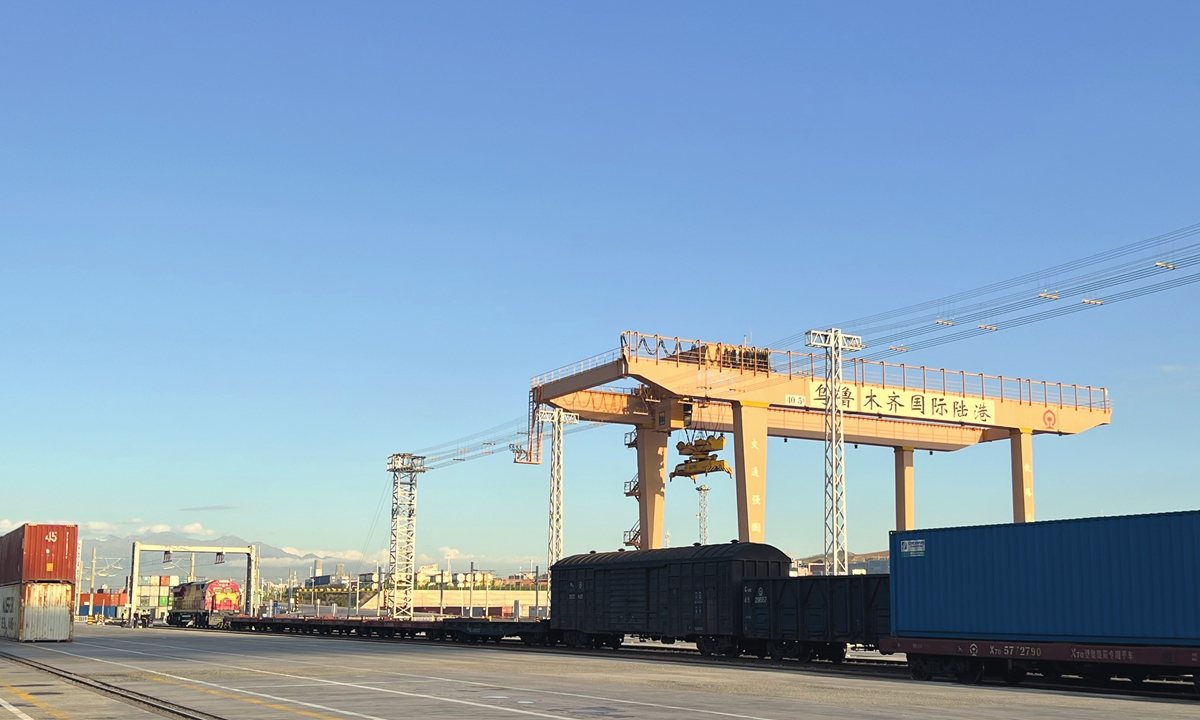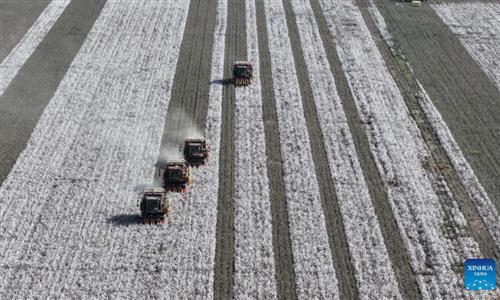Xinjiang shows ‘unlimited potential’ in becoming BRI business and logistics hub, boosted by new FTZ policies

A view of the International Land Port in Urumqi, capital of Northwest China's Xinjiang Uygur Autonomous Region in September, 2023 Photo: Li Xuanmin/GT
At China-Kazakhstan International Cooperation Center in Horgos, Northwest China's Xinjiang Uygur Autonomous Region, a group of tourists from neighboring Kazakhstan embarked on a shopping spree on Saturday, buying duty-free Chinese commodities including locally made Nang, a traditional flatbread, to clothes, shoes and home appliances.
The center, part of the first cross-border free trade zone in China, is welcoming an increasing number of foreign tourists as well as businessmen from Russia and Central Asian countries, amid the region's enhanced efforts in westward opening-up and well-developed local logistic network there.
Ji Gang, general manager of Jindiao Central Square, a large shopping mall at the cooperation center, envisioned that the center will be transformed into a shopping paradise for foreigners and a magnet for foreign investment.
The State Council, China's cabinet, on Tuesday publicized a plan to build the Xinjiang FTZ. Three areas were included in the 179.66-square-kilometers FTZ, including the regional capital of Urumqi, Kashi prefecture and Horgos. It is the first such zone in China's northwest border region and the 22nd pilot FTZ in China.
Local entrepreneurs said they have witnessed palpable changes due to a series of new FTZ policies.
"There are now more visitors from not only Central Asia and Russia, but also from Europe, South Korea and Dubai and elsewhere, in pursuit of business opportunities here," Ji told the Global Times.
Visitors thronging in
A Xinjiang-based Russian-language translator surnamed Wang told the Global Times that, lately she has been receiving more business representatives and other visitor groups from Central Asia and Russia. "The Horgos cooperation center and the Urumqi International Land Port are the hotspots, as they are windows to the FTZ. Some also visited new-energy vehicle (NEVs) enterprises and agricultural machinery companies," Wang said.
Xinjiang - which sits at China's westernmost frontier bordering eight countries including Mongolia, Russia, Kazakhstan, Kyrgyzstan, Tajikistan, Afghanistan, Pakistan and India- will see its door open wider and wider thanks to the new FTZ. Local businessmen and observers also take note of the region's "unlimited potential" in transforming itself into a regional industrial, transportation, business and financial hub.
At a press briefing on Wednesday, Guo Tingting, a vice minister of the Ministry of Commerce (MOFCOM), said that the government will support the Xinjiang pilot FTZ in attracting domestic and foreign investment.
The Xinjiang FTZ will improve a service guarantee mechanism for foreign investment and support eligible foreign-funded enterprises in enjoying equal access to preferential development policies, according to Guo.
"Foreign financial institutions will be supported in setting up banking, insurance, securities and other financial branches in the Xinjiang pilot FTZ to provide a wide range of internationalized financial products and services," said Guo.
The FTZ plan encourages the area to carry out cross-border yuan trade settlements with the partner countries participating in the Belt and Road Initiative (BRI) in sectors including bulk commodity trade and overseas project contracting.
Observers said that, Xinjiang, sitting at the heart of the Eurasia continent as well as the intersection of China-Pakistan Economic Corridor and the China-Central Asia-West Asia route, has an incomparable geographic advantage in access to massive neighboring markets with a total population of 2.8 billion. The region is also a core area of the Silk Road Economic Belt after 10 years of BRI development. Those would all be the region's key drawers for overseas investments.
"Eastward, it could target the Asia-Pacific markets. Westward, the region is a gateway to markets in Central Asia, West Asia and the Middle East," Zhao Yi, assistant to the general manager at the International Land Port in Urumqi, told the Global Times.
The plan also supports the relocation of labor-intensive industries in China's eastern provinces to Xinjiang. Analysts said the relocation is conducive to reshape Xinjiang into a center in the Eurasia supply chain.
Magnet for investment
Currently, a number of foreign companies including German carmaker Volkswagen have built up manufacturing factories in Xinjiang. And, the new FTZ is expected to grow more mature after three to five years of development. Observers believe that the booming development of FTZ would further stimulate foreign investors' interest in investing in the resource-rich region.
The Xinjiang FTZ has a space of 179.66 square kilometers, larger than existing FTZs in other parts of China that generally have an area within 120 square kilometers.
The Global Times noticed that the Xinjiang FTZ could undertake certain unique tasks compared to other FTZs. The plan makes clear the FTZ's role in building a comprehensive logistical hub connecting Eurasia, in addition to carrying out common missions such as innovative experiments in trade, investment, finance and manufacturing.
Xinjiang is an important node for China-Europe freight train, a flagship BRI project that is deemed as an Asia-Europe "golden passage." And the region is home to two land ports tailored for undertaking express freight service. As of the end of September, over 60,000 China-Europe freight trains have passed through Xinjiang, accounting for more than half of the total in China.
In a detailed chapter on logistics, the plan said it encourages developing China-Kyrgyzstan-Uzbekistan multimodal highway-railway transport, exploring China-Pakistan multimodal transport and the joint construction of China-Kyrgyzstan-Uzbekistan Railway.
In response to the plan, Zhao said the Xinjiang port authorities have been mulling over plans to open more westward routes to Europe. "We are also negotiating with the Kazakhstani side, to establish business-to-business ties to facilitate custom clearing efficiency," Zhao noted.
Analysts noted that the improved connectivity will pave way for establishing a "Eurasia economic corridor," and the region's accelerated economic integration with Central Asia.
Yu Chengzhong, chairman of Xinjiang-based trading company Horgos Jinyi International Trade Co, told the Global Times on Thursday that the firm will seize the business opportunities brought by the FTZ and strengthen cooperation with companies in Central and West Asia.
The company plans to invest 500 million yuan to build a 500,000-square-meter overseas warehouse in Alma Ata, south Kazakhstan, and set up multiple exhibition centers including vegetable and fruit, small commodities and other daily necessities, as well as machineries within the warehouse, according to Yu. The company's export value to Central Asia could climb up to $1.2 billion this year, almost doubling from $683 million last year.
In the first eight months, Xinjiang's foreign trade surged by 51.2 percent year-on-year to reach 219.19 billion yuan ($30 billion). Its trade with five Central Asian countries grew by 59.1 percent to hit 176.64 billion yuan, customs data showed.



